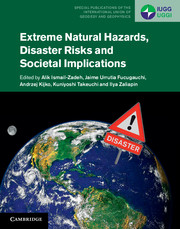16 results
Part VII - Disaster risks and societal implications
-
- Book:
- Extreme Natural Hazards, Disaster Risks and Societal Implications
- Published online:
- 05 May 2014
- Print publication:
- 17 April 2014, pp 331-398
-
- Chapter
- Export citation
Acknowledgments
-
- Book:
- Extreme Natural Hazards, Disaster Risks and Societal Implications
- Published online:
- 05 May 2014
- Print publication:
- 17 April 2014, pp viii-ix
-
- Chapter
- Export citation
Part III - Case studies: Latin America and the Caribbean region
-
- Book:
- Extreme Natural Hazards, Disaster Risks and Societal Implications
- Published online:
- 05 May 2014
- Print publication:
- 17 April 2014, pp 143-166
-
- Chapter
- Export citation

Extreme Natural Hazards, Disaster Risks and Societal Implications
-
- Published online:
- 05 May 2014
- Print publication:
- 17 April 2014
Extreme Natural Hazards, Disaster Risk and Societal Implications - Half title page
-
- Book:
- Extreme Natural Hazards, Disaster Risks and Societal Implications
- Published online:
- 05 May 2014
- Print publication:
- 17 April 2014, pp i-0
-
- Chapter
- Export citation
Extreme Natural Hazards, Disaster Risks and Societal Implications - Title page
-
-
- Book:
- Extreme Natural Hazards, Disaster Risks and Societal Implications
- Published online:
- 05 May 2014
- Print publication:
- 17 April 2014, pp iii-iii
-
- Chapter
- Export citation
Part VI - Case studies: Asia and the Pacific Region
-
- Book:
- Extreme Natural Hazards, Disaster Risks and Societal Implications
- Published online:
- 05 May 2014
- Print publication:
- 17 April 2014, pp 279-330
-
- Chapter
- Export citation
Series page
-
- Book:
- Extreme Natural Hazards, Disaster Risks and Societal Implications
- Published online:
- 05 May 2014
- Print publication:
- 17 April 2014, pp i-ii
-
- Chapter
- Export citation
Part V - Case studies: the Middle East
-
- Book:
- Extreme Natural Hazards, Disaster Risks and Societal Implications
- Published online:
- 05 May 2014
- Print publication:
- 17 April 2014, pp 241-278
-
- Chapter
- Export citation
Contents
-
- Book:
- Extreme Natural Hazards, Disaster Risks and Societal Implications
- Published online:
- 05 May 2014
- Print publication:
- 17 April 2014, pp v-vi
-
- Chapter
- Export citation
Copyright page
-
- Book:
- Extreme Natural Hazards, Disaster Risks and Societal Implications
- Published online:
- 05 May 2014
- Print publication:
- 17 April 2014, pp iv-iv
-
- Chapter
- Export citation
Part I - Introduction
-
- Book:
- Extreme Natural Hazards, Disaster Risks and Societal Implications
- Published online:
- 05 May 2014
- Print publication:
- 17 April 2014, pp 1-26
-
- Chapter
- Export citation
Preface
-
- Book:
- Extreme Natural Hazards, Disaster Risks and Societal Implications
- Published online:
- 05 May 2014
- Print publication:
- 17 April 2014, pp vii-vii
-
- Chapter
- Export citation
Part IV - Case studies: Africa
-
- Book:
- Extreme Natural Hazards, Disaster Risks and Societal Implications
- Published online:
- 05 May 2014
- Print publication:
- 17 April 2014, pp 167-240
-
- Chapter
- Export citation
Part II - Extreme hazards and disaster risks
-
- Book:
- Extreme Natural Hazards, Disaster Risks and Societal Implications
- Published online:
- 05 May 2014
- Print publication:
- 17 April 2014, pp 27-142
-
- Chapter
- Export citation
Index
-
- Book:
- Extreme Natural Hazards, Disaster Risks and Societal Implications
- Published online:
- 05 May 2014
- Print publication:
- 17 April 2014, pp 399-402
-
- Chapter
- Export citation



